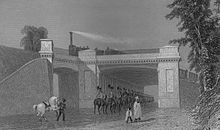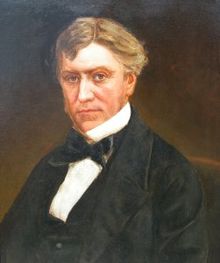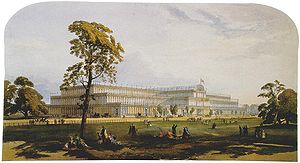- Charles Fox (civil and railway engineer)
-
Sir Charles Fox Born 11 March 1810
Derby, United KingdomDied 11 June 1874 (aged 64)
Blackheath, LondonSpouse Mary Fox (née Brookhouse) Children Charles Heyland Fox
Sir Francis Fox
Sir Charles Douglas FoxParents Dr. Francis Fox Work Engineering discipline Civil engineer
Structural engineerInstitution memberships Institution of Civil Engineers, Institution of Mechanical Engineers, Fellow of the Royal Asiatic Society and Royal Geographical Society Significant projects The Crystal Palace Sir Charles Fox (11 March 1810, Derby, United Kingdom – 11 June 1874) was an English civil engineer and contractor. His work focused on railways, railway stations and bridges.
Contents
Biography
Born in Derby in 1810, he was the youngest of four sons of Dr. Francis Fox. Initially trained to follow his father's career, he abandoned medical training at the age of 19 and became articled to John Ericsson of Liverpool, working with him and John Braithwaite on the Novelty locomotive, which he drove in the Rainhill trials on the Liverpool and Manchester Railway. He acquired a taste for locomotive driving and was employed on the Liverpool and Manchester Railway, being present at its opening.
In 1830 Fox married Mary, second daughter of Joseph Brookhouse, by whom he had 3 sons and a daughter.
Railways
One of his earliest inventions, patented in 1832, was the railway switch (points in the UK), which superseded the sliding rail used up to that time.
 A contemporary engraving of Denbigh Hall skew Bridge on the London and Birmingham Railway
A contemporary engraving of Denbigh Hall skew Bridge on the London and Birmingham Railway
In 1837 Robert Stephenson appointed him as one of the engineers on the London and Birmingham Railway, where he was responsible for Watford tunnel and the incline down from Camden Town to Euston. He presented an important paper on the correct principles of skew arches to the Royal Institution. In 1837 Herbert Spencer, whose father George Spencer had been Fox's tutor when young, joined him as an assistant engineer.[1]
Fox then entered into partnership with the contractor Joseph Bramah to form the company Bramah, Fox and Co., which when Bramah retired became Fox, Henderson and Co., of London, Smethwick, and Renfrew. The company specialised in railway equipment, including wheels, bridges, roofs, cranes, tanks and permanent way materials. It also experimented with components for suspension and girder bridges, with Fox reading a paper before the Royal Society in 1865. The company was responsible for many important station roofs including Liverpool Tithebarn Street, (1849–50), Bradford Exchange (1850), Paddington and Birmingham New Street.
Crystal Palace
Fox and Henderson's expertise with structural ironwork led Joseph Paxton to invite them to build The Crystal Palace for The Great Exhibition of 1851. Due to its innovative modular design and construction techniques, it was ready in nine months. For their work, Fox, Cubitt and Paxton were knighted on 23 October 1851.[2] After the exhibition they were employed by the Crystal Palace Company to move the structure to Sydenham, re-erecting and enlarging it on Sydenham Hill, thereafter known as Crystal Palace.
In 1856 Fox Henderson went into liquidation after sustaining losses building railways in Zealand, Denmark. In 1857 he established a new civil and consulting engineering practice with two of his sons, Douglas and Francis, and in 1860 formed a partnership with his two sons, the firm being known as Sir Charles Fox and Sons.
Their engineering work included the Medway bridge at Rochester, three bridges over the Thames, a swing bridge across the River Shannon in Ireland, a bridge over the Saône at Lyon and many bridges on the Great Western Railway. Railways upon which Fox worked included the Cork and Bandon, Thames and Medway, Portadown and Dungannon, East Kent, Lyons and Geneva, Macon and Geneva, Wiesbaden and the Zealand (Denmark) lines. Fox was also engineer to the Queensland, Cape Town and Wynberg Railway and the Toronto narrow gauge lines.
Narrow-gauge railways
Fox became an expert in narrow-gauge railways and in conjunction with George Berkley he constructed the first narrow-gauge line in India, and later constructed narrow-gauge lines in other parts of the world.
Fox and Sons engineered the complex scheme of bridges and high-level lines at Battersea for the London Brighton and South Coast Railway, London, Chatham and Dover Railway and London and South Western Railway and the approach to Victoria Station, London, including widening the bridge over the Thames.
Fox was also a member of the Institution of Civil Engineers from 1838 until his death, a founder member of the Institution of Mechanical Engineers from 1856 to 1871 and a fellow of the Royal Asiatic Society and Royal Geographical Society.
Sir Charles Fox died at Blackheath, London on 14 June 1874, at the age of sixty-four. He was buried at Nunhead Cemetery on 18 June.
Other projects
- East Kent Railway
- Cork and Bandon Railway
- Thames and Medway Railway
- Portadown and Dungannon Railway
- Eastern sections of the Lyon and Geneva Railway
- Mâcon and Geneva Railway
- Wiesbaden Railway
- Danish Zealand Railways
- Bridge over the River Medway at Rochester
- Bridge over the River Thames at Barnes, Richmond, and Staines
- Station buildings for Paddington, Waterloo and Birmingham New Street
- Narrow-gauge railways in Queensland, Australia, Cape of Good Hope, South Africa and Canada
- Assisted George Berkley with the first narrow-gauge railway in India.
References
- ^ Cooper, B., (1983) Transformation of a Valley: The Derbyshire Derwent, Heinemann, republished 1991 Cromford: Scarthin Books
- ^ "Windsor-Castle, October 23, 1851". London Gazette, issue 21257. 28 October 1851. p. 2812. http://www.gazettes-online.co.uk/ViewPDF.aspx?pdf=21257&geotype=London&gpn=2812&type=. Retrieved 2008-05-26.[dead link]
Further reading
- Fox, Sir Francis (1904). Some Engineering Reminiscences. John Murray.
- Sir Francis Fox. "Some Engineering Reminiscences" (Web page). Crystal Palace Campaign. http://www.crystal.dircon.co.uk/foxfrancisr.htm. Retrieved 2007-07-01.
- Mike Chrimes, Librarian of the Institution of Civil Engineers. "Civil Engineers, Architects, etc" (Web page). Steam Index: British steam locomotive history. http://www.steamindex.com/people/civils.htm. Retrieved 2007-07-01.
- "Fox, Sir Charles" (Web page). You & Yesterday. http://www.youandyesterday.co.uk/articles/Fox,_Sir_Charles. Retrieved 2007-07-01.
- Fox, Sir Charles (1810–1874), Robert Thorne, Oxford Dictionary of National Biography, 2004, accessed 19 Aug 2011
Categories:- 1810 births
- 1874 deaths
- People from Derby
- English civil engineers
- Fellows of the Royal Geographical Society
- Fellows of the Royal Asiatic Society
- Fellows of the Institution of Mechanical Engineers
- British people in rail transport
- Knights Bachelor
- Burials at Nunhead Cemetery
Wikimedia Foundation. 2010.


